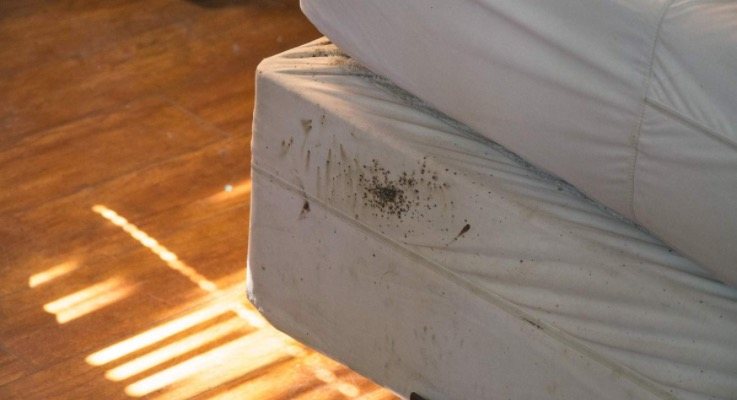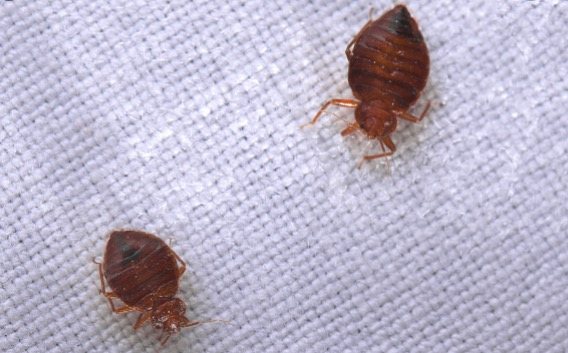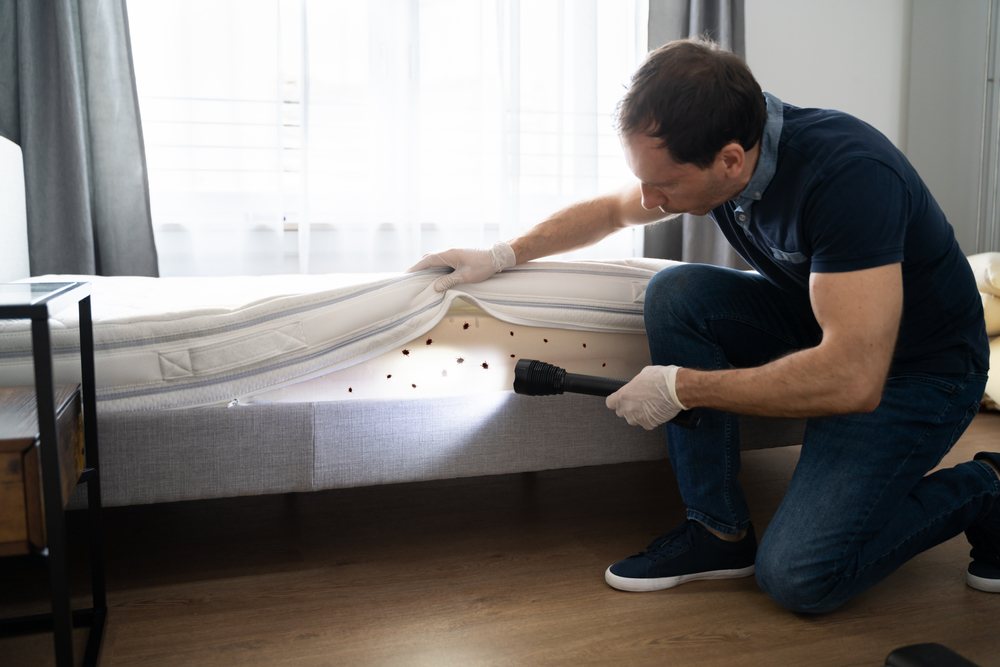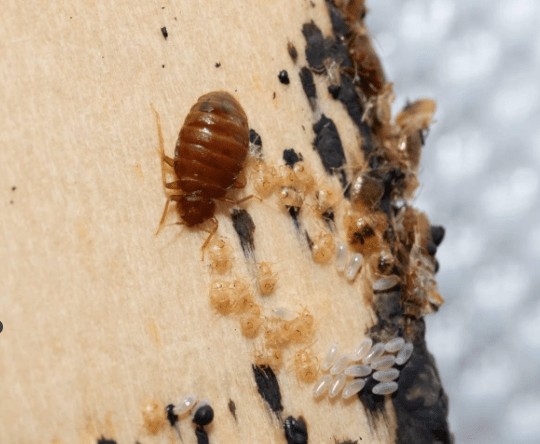Indoor pests in general can be a nuisance.
But none of them are quite as difficult as bed bugs.
Among the most resilient and persistent indoor pests out there…
Bed bug infestations are becoming more common in all 50 states.
A bed bug infestation can be difficult to detect, and even more difficult to eradicate.
Why?
Because bed bugs have an uncanny ability to not only hide but stay hidden for long periods of time.
Therefore, traditional methods of bed bug treatment may not persist to all bed bugs, especially in those hard to reach places.
This is why identification and detection are so important to removing an infestation. If you don’t know exactly where bed bugs are hiding, it’s less likely you’ll successfully remove them entirely.
You shouldn’t risk bed bug reoccurrence as treatments can be expensive and time-consuming.
Follow our guidance below on how to successfully check, identify, and prevent bed bugs in your home or apartment.
Page Contents:
Here’s How to Check for Bed Bugs
Bed bugs are difficult to find during the day because they only come out at night.
Luckily, at any stage of development bed bugs are visible to the human eye. If the insects are too small to see, it’s likely you have an infestation from a different but similar looking pest.
So what should you do?
Look for Signs of Bed Bugs.
Since bed bugs themselves can be hard to find, you can look for evidence that they were once present.
Evidence can be anything from…
1. Brown or red stains on the mattress or sheets.
Red stains indicate blood that has dripped or spilled during the feeding process. Brown stains are actually a form of bed bug excrement. These stains can look like small dots, smears, or streaks.

2. Bed bug Eggs.
These can be difficult to spot if you’re not extremely observant, but overall eggs are small, pale, almost translucent spheres that are around 1 mm (0.10 cm) in size. Eggs can usually be seen in clusters within the folds of your mattress or along baseboards.
Note: If you’re interested in learning more about bed bug eggs, check out our complete guide.
3. Bed bug shed skin or exoskeleton.
Bed bugs shed their skin and go through what’s called a molting process 5 different times during their life cycle. If you do notice tiny shed skins all over the place, that could be an indicator of a severe, more seasoned infestation.
4. Musty smell.
Bed bugs let out a certain mix of chemicals in order to communicate with each other. These chemicals involve something called histamine, and can contain a strange scent.
IMPORTANT:
When you’re looking for bed bugs you should wear gloves to protect your hands. These can be vinyl or latex gloves that are dark in color. Gloves that are lighter in color may blend in with bed bug eggs or nymphs making them harder to spot.

Any of the above methods can help give determine whether or not you might have an infestation.
Though these are alternatives to the best, move obvious method out there.
Which is finding actual live bed bugs.
But how do you find them?
How to Find Bed Bugs
Locating bed bugs is a tricky business.
Unless you know where to look.
Bed bugs are usually found in the bedroom because they prefer to be closer to a food source.
Since bed bugs cannot travel very fast on their own…
(around 2 to 3 feet per minute).
They also prefer to feed when their hosts are asleep, so they can get a meal without disturbance.
Within the bedroom…
Here are some common locations you can find bed bugs.
1. The Mattress & box spring.
Remove the bedspread, comforter, sheets, etc.. and look along the folds and corners of the mattress for signs of bed bugs. Check the box spring as well for any rips/tears showing that bed bugs have crawled inside.
Note: If you do notice bed bugs around your mattress, consider purchasing a special mattress encasement to protect your mattress/box spring from being infested with bed bugs.
2. Check within, beneath, and around furniture.
Your bedroom furniture, specifically things like nightstands, dressers, or wall hangings can be hotspots for bed bugs. These insects love to hide under clothes or cracks/crevices within your furniture. We would recommend moving the furniture so you can look around the perimeter of the room.
3. Inspect curtains and other laundry.
Pull open the curtains and look into the folds where they could be hiding. Bed bugs usually stick around the bottom of curtains, but they are able to crawl up them as well.
Expert Tip: If you have very high ceilings and aren’t able to check closer to the top of curtains or walls, it’s worth investing in a ladder to ensure all areas are checked.
Where Else to Look for Bed Bugs
You should also be checking spaces that are less common.
Some examples are:
1. Furniture outside of the bedroom.
Now the bedroom should absolutely be the first place you check, but that doesn’t discount the ability for these insects to migrate over to your kitchen or living room. Couches or lounge furniture should be checked as well.
(Make sure to remove the cushions and inspect areas inside the couch with a flashlight).
2. Outlets and Appliances.
Bed bugs can hide around outlets or electrical items. These are easy targets for them to hide and go unseen, so unscrew outlets and move appliances around to see if you can spot any crawling critters.

3. Lift up carpets, wallpaper, or wall-hangings.
These areas should be some of the last places you check, and it should be only done if you’re confident some sort of infestation exists. It’s unlikely that you’ll find bed bugs in these areas without finding them anywhere else.
How to Spot Bed Bugs
Now that you know where to look for bed bugs…
How do you identify them?
How do you tell them apart from other insects?
The first step to spotting bed bugs is to learn what they look like.
Bed bugs have small, flat, oval shaped bodies that are about the size of a pumpkin seed. They’re typically black/brown if they haven’t fed recently.

Shortly after a meal, bed bugs tend to balloon up to a more circular shape and gain a shiny red tint.
The common bed bug is considered to have a “true bug” shape (also called Hemiptera) consisting of 3 segments, antennae, and an exoskeleton.
Is it common to spot just one bed bug?
This is a difficult question to answer. Bed bugs are usually found in clusters, although it’s not uncommon to see one stray bed bug scurrying across the room. But in general, if you see a cluster of bugs in different stages of life (eggs, nymphs, adults), there’s a good chance these are bed bugs.
Note: If you do spot just one bed bug, you will want to think that bug was just an anomaly. Though that’s not usually the case. Even if you spot just one bed bug, it’s likely that you have an infestation on your hands.
Bed Bugs Keep Coming Back
There are a couple of reasons why bed bugs can return even after you have undergone bed bug treatment.
- If bed bugs are infesting your work, school, friend’s house, or another common place you visit, it’s possible that every time you visit this place you keep bringing them back home.
- It’s also possible that you never fully got rid of bed bugs in the first place. Often times conventional treatment methods don’t persist to the level of fully eradicating bed bugs.
Remember: If even one female bed bug is left behind, you can have a total reoccurrence in a matter of 2 to 3 months.

Though DIY methods and other home remedies can be effective in mitigating an infestation or treating a local infestation, it will usually fail to remove a full-scale infestation entirely.
In that case, you’ll want to get the help of a pest control professional.
How to Check for Bed Bugs in a Hotel
Looking to check into a hotel for a vacation? To avoid ruining your trip, it’s best to quickly inspect your hotel room for pests before you spend the night.
Unfortunately, any temporary residence like a hotel or motel can be a hot spot for bed bugs.

With a revolving door of foot traffic, there is ample opportunity for travelers to bring bed bugs into a hotel room. Unfortunately, hotel bed bug complaints have been increasing in the past decade, and no hotel is immune.
Here are the 5 steps for checking your hotel room and traveling without bed bugs.
1. When you first enter the hotel room, put your luggage on a rack or in the bathroom. DO NOT put your luggage near the bed or on the floor.
2. Pull back the bed sheets and blankets, especially at the head of the bed. It’s also recommended that you slightly lift the mattress to glance underneath.
(Use your flashlight when inspecting if possible).
3. Take a quick look at any upholstered furniture, whether that be a couch or recliner. Make sure to check at the seams as well.
4. Continue to keep your suitcase on a luggage rack throughout the length of your stay. You can also procure plastic trash bags and keep your luggage in that.
(Though that can feel a bit extreme).
- If you think you may have brought bed bugs home, quickly bring your luggage to the laundry and wash/dry all clothes on high temperatures.
How to Check for Bed Bug Bites
Victims of bed bug bites typically experience mild skin irritation and itchiness. Bites can last anywhere from 2 to 25 days.
These creatures can bite anywhere on your body, although they typically stay around the upper areas.
Common areas are typically where your skin is exposed while sleeping.
This includes your:
- Neck
- Arm
- Shoulders
- Hands
- Face
If you do experience bites in areas around your lower body, you should inspect the bites closely. Unless you know exactly what bed bug bites look like, there’s a good chance you have mistaken these bites for similar insects.
Almost all bed bug bites will produce some degree of discomfort, but there are some less common symptoms you could experience.
These involve:
- A burning sensation.
- A bed bug rash or hives (due to some sort of allergic reaction).
- Small red bumps or welts in a cluster.
- Inflammation or raised flat patches.
While fairly rare, some victims can develop severe reactions and health effects from bed bugs.
At the end of the day…
If you feel an intense itching sensation you should inspect your body immediately. Once bites are found you should take measures to ease symptoms and recover from the bites.
Consider a Bed Bug Lawsuit
If you were the unlucky victim of a bed bug infestation in your hotel room or apartment, you may be eligible for financial compensation.
(By holding the property owner liable for damages).
Get connected with a lawyer for your free case evaluation. You can call us for your quick and easy consultation at (855) 733 9217 or by submitting your case here.
You pay nothing unless you win your case. Get in touch today!




